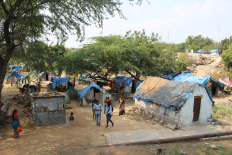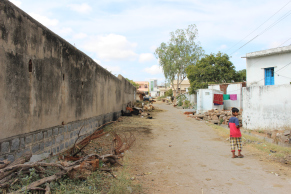Governance of sanitation in a rapidly changing world
This blog by Sarah Cooper is the second in a series of blogs about the work of the Rurality as a Vehicle for Urban Transformation (RUST) project. It was originally posted on the RUST website. A video profile of of an informal settlement in Hyderabad, where the project research is based, is also available.

Our world is rapidly becoming more urbanised. Expansion of economic development and migration of people from rural areas has seen the transformation of cities into mega-metropolises. Sixty-eight percent of the world’s population are due to live in an urban area by 2050. This rapid rural to urban transition poses significant challenges for the provision and governance of public services such as electricity, sanitation, transport and food.
Inadequate, haphazard planning, and the informal settlement of migrant communities on the expanding peripheries of these cities referred to as peri-urban areas, frequently fall outside the boundaries of the local government. This lack of provision can lead to unsustainable activities which result in environmental problems such as pollution and health risks and also societal challenges such as discrimination, inequity and marginalisation.
Sanitation is a fundamental and important component of these urban systems. Poor sanitation poses significant risks to the economy and health by increasing incidences of diseases such as diarrhoea typhoid and dysentery. Sanitation also negatively affects the environment through pollution and the reduction of biodiversity.
So in these rapidly changing rural to urban contexts, one of the biggest challenges is how to provide sanitation which is safe, affordable, functional as well as sustainable for everyone. Especially in informal communities which have no sanitation facilities or have resulted in messy, haphazard, unsustainable solutions, and developing countries, where existing sanitation facilities and infrastructure are often deteriorating and dysfunctional adding to the environment and health burden. So how do we govern sanitation in these highly complex situations?
Looking forward
The main overarching aim of the RUST project aims to address this sanitation challenge by investigating the extent to which aspects of rural and urban sanitation can be linked to improve health and the economy by driving sustainable sanitation solutions in India. The study takes Hyderabad a future mega-city as a case study and data is collected across two transects which run from urban, peri-urban and rural locations across the city. Locations are selected according to whether they are rich or poor and formal or informal. Informal referring to temporary or slum accommodation which may or may not be recognised by the local municipality.

Work package four (WP4) focuses on the institutional environmentwhich governs the different aspects of sanitation. Institutions often defined as the ‘rules of the game’ that govern the behaviour of individuals and organisations. For example, this can include ‘formal’ rules such as policy, laws and administrative legislation but also ‘informal’ rules such as social beliefs and values which society function under.
In Hyderabad, the main organisations responsible for sanitation are the Hyderabad Metropolitan Water Supply and Sewerage Board (HMWSSB) and the Municipal Administration (CDMA) who work closely to implement the national sanitation policy of India, the Swachh Bharat Mission (SBM) meaning ‘Clean India Mission.’ The primary focus of SBM has focused on behaviour change to reduce open defection and the provision of finance to construct toilets. WP4 will help highlight the extent to which this policy has been a success and inform what still needs to be done in the future. WP4 will explore the institutional environment of sanitation by asking questions such as:
- Are there any gaps in India’s sanitation policy? India’s sanitation policy, Swachh Bharat (meaning ‘clean India’) has two separate policies for rural and urban. How suitable are these policies for the peri-urban areas with its unique characteristics? Has everybody benefited?
- How do flows and networks of communication between organisations, actors and communities inhibit or facilitate sanitation? Some people have higher social status within the community meaning they are more able to access information and able to benefit from financial incentives than people who are more marginalised. How does this differ for informal and formal settlements?
- Where and who do communities’ get their sanitation information from? Accessibility to information can be determined by different factors such as location, wealth, timing, and social connectedness. For example, wealthier people may access information online. Whereas poorer people maybe more dependent on informal networks such as asking family and friends.
- Who do people trust the most for their sanitation needs? Issues of trust are important. For example, levels of distrust in the government may influence the extent communities engage in specific behaviour such as reducing open defecation by encouraging people to use toilets.
- Is there adequate connectivity between different organisations to ensure effective sanitation? For example, the disposal of fecal waste is often undertaken by private service providers but the processing of fecal is undertaken by the municipality. Lack of communication between these two facilities may result in unsafe disposal into the environment.
Essentially, WP4 is about the human nut and bolts of sanitation. How sanitation is organised. What is working and what is not working. By unravelling this institutional context, the research will be fundamental in informing the future planning of effective sanitation in Hyderabad.